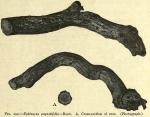 563. ECHINACEA, N.F.—The root of Echina'cea angustifo'lia De Candolle. Habitat: Western United States. This plant has grown into considerable importance, especially among the eclectic practitioners, in the treatment of phagedenic ulcerations, boils, various forms of septicaemia, etc. The common name of the plant is "nigger-head." The flower-head has from twelve to fifteen rays, 2 inches long, rose-colored or red, drooping; receptacle conical, with finely tipped chaff, longer than the disk-florets; disks purplish. The root has a brownish-black color, the epidermis shrunken causing longitudinally twisted wrinkles. Over 200,000 pounds were consumed in 1903. Since that time the demand has been kept up quite regularly at the same figure.
563. ECHINACEA, N.F.—The root of Echina'cea angustifo'lia De Candolle. Habitat: Western United States. This plant has grown into considerable importance, especially among the eclectic practitioners, in the treatment of phagedenic ulcerations, boils, various forms of septicaemia, etc. The common name of the plant is "nigger-head." The flower-head has from twelve to fifteen rays, 2 inches long, rose-colored or red, drooping; receptacle conical, with finely tipped chaff, longer than the disk-florets; disks purplish. The root has a brownish-black color, the epidermis shrunken causing longitudinally twisted wrinkles. Over 200,000 pounds were consumed in 1903. Since that time the demand has been kept up quite regularly at the same figure.
In cross-section are seen wood-wedges and medullary rays, colored dark gray or blackish; fracture short and rough; taste peculiar and somewhat acrid and biting, reminding one of pyrethrum; odor heavy, mousey, accompanied by a peculiar pungency. The root contains a very small percentage of alkaloid and a crystalline principle soluble in carbon disulphide. Active principle contained, apparently, in an oleoresin which represents the medicinal properties. Allied species: Echinacea purpurea.

